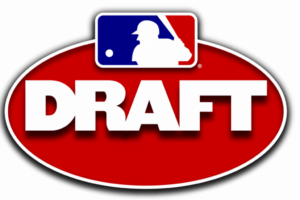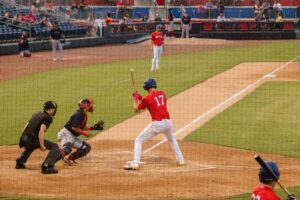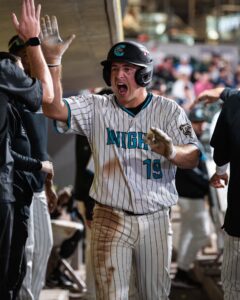White Sox Spring Training Preview – Prospect Style
It’s time. Today, we can utter that beautiful four-word phrase, “pitchers and catchers report”. Spring Training officially opens today for the White Sox.
Of course lots of players have already been there for days or weeks, so this is just the nominal opening which receives ceremonial focus. Like Christopher Columbus “discovering” America, the players who arrive today aren’t really first on any factual basis, but a holiday is a holiday. Credit to Matthew Smith for the photo capturing the spirit of the moment in Columbus’ facial expression, as he arrived at Camelback Ranch only to realize who’s in right field.
As a White Sox fan, you may be inundated with Spring Training primers and previews from every beat writer and blog on the block. So we’re giving you a different angle – a preview of what to watch in Spring Training as it pertains to prospects and minor leaguers. If you want a more overall view, there will be plenty of choices – here is a good one from The Catbird Seat, one of our favorite general Sox blogs.
One more general note: we will have multiple writers at Camelback this spring at various times, taking video, photos and notes from the ballpark and the back fields. So look for that content over the next six weeks or so.
Here are the prospects and recent/current minor leaguers who were invited to major league camp but aren’t definitely slotted for the active roster, and what to watch for for each of them. Some of them may not technically be prospects anymore (i.e. Erik Johnson), but can essentially be treated as such for the purposes of the team view. I’ve broken them up into three categories.
PLAYERS ON THE 40-MAN ROSTER
RHP Erik Johnson: Vying for the 5th starter slot, though he’s probably well behind Mat Latos (and his major league deal) for that job and is competing with Jacob Turner (who is out of options) as well. Prior to Latos signing he looked like a lock for the job, now not so much. He’s one of the few here truly competing for an Opening Day role, and for him the key is about whether he can carry over his big improvements from 2015. We’ll see that pretty quickly once he pitches in games, and he’s one of the key guys to watch in March. When he’s his 2015 self, he looks like a major league, back end starter.
RHP Chris Beck: Unlikely to make the club out of the gate, but there’s a good chance you’ll see him in Chicago sometime in 2016. Beck’s floor is high as a worm-burning, innings-eating role pitcher who also could be a back end starter. The wildcard is his Ulnar Nerve Translocation surgery and missed time in 2015 that caused him to miss more than half the season, and it’s not clear if his arm will be ready for a full year of starting workload. So keep an eye on his innings, velocity and level of rust, if any. The bullpen could be an option as well, where his power sinker and change-up combo should play, possibly as a long man.
RHP Scott Carroll: Similar in potential role to Beck, Carroll has proven he can provide major league innings and has potential value starting or in the bullpen. In terms of the depth chart, Carroll is probably behind two or three pitchers for a rotation spot, and a similar number in the pen. That makes the latter much more likely. With Carroll you pretty much know what you’re going to get, so he just needs to stay healthy and hope for an opportunity.
RHP Tommy Kahnle: The White Sox traded a decent pitching prospect (Yency Almonte) for this reliever and put him on the 40-man roster, so this isn’t just a filler pickup. The club saw something causing his control issues that they think they can fix, and he’s very much in the mix for a bullpen spot (especially if they carry 8 relievers). Watch his command and how he works the strike zone – if he’s throwing strikes and staying in the lower half of the zone, that’s a sign he’s taken to the intended changes.
RHP Daniel Webb: Like Kahnle, Webb has major league experience and tantalizing stuff, but has had trouble putting it together at the major league level. He’s also competing for a bullpen role with the big club, and probably very close to (though perhaps just behind) Kahnle going in. Yet another similarity is the relationship with the strike zone – when Webb is throwing his upper 90’s gas in the zone, everything else plays up and he’s effective. So keep an eye on where he’s placing his pitches.
LHP Zach Phillips: Placed on the 40-man roster just before the Rule 5 Draft, Phillips is part of the lefty specialist depth the club is trying to build. If Dan Jennings struggles, Phillips is likely the next best option. The 28-year old hasn’t been in the majors since 2013, but he was quite effective in AAA Charlotte in 2015, especially against left-handed batters (.556 OPS, .213 AVG despite a .341 BABIP against him). He just needs to show he can get outs in lefty-lefty scenarios, and wait for someone faltering above him.
UTIL Leury Garcia: His value is wound up in speed, and the ability to play passable or better defense at nearly any position on the field. Carlos Sanchez is pretty much guaranteed the utility infielder role, so Garcia is playing for a 4th bench slot (if they even use one), and he’s got competition there as you’ll see. He put up some nice hitting numbers in AAA in 2015, but hasn’t shown anything like that in the majors, so can he hit? That’s what he needs to show in Arizona to have a shot.
3B Mike Olt: This fallen prospect was one in the parade of attempts to find a starting third baseman for the major league club in 2015, a problem now solved with the acquisition of Todd Frazier. Olt is also competing for that final bench spot, but he can really only play corner infield (with struggles) and hasn’t shown much at the plate. He’d have to have a big spring on both sides of the ball to be on the plane to Chicago come April.
3B Matt Davidson: In theory, Davidson is in the running for a bench slot. But with at most one of those jobs open to him (Sanchez, the backup catcher and a 4th OF already spoken for) and the fact that he struck out in more than 30% of his plate appearances in this 3rd trip through AAA, the chances are very slim. This spring is really about one thing for Matt – showing he can make use of his substantial power by making consistent contact. If he does that, and carries it to Charlotte, he might have a shot to revive his prospect stock.
Catchers Rob Brantly and Kevan Smith: Neither are getting a job on Opening Day barring an injury; but as both the slated major league catchers have some history of that, so which of these two shows they’re the next man up is worth monitoring. For Smith, while his defense has improved he struggled at the plate for the first time as a pro in 2015 at AAA. So watch how he’s looking in the batter’s box. For Brantly, the questions are more about defense, and whether his relative success at the plate in the minors (and previously, in the majors) can return at the highest level. It’s hard to handicap this race, with both likely in Charlotte again, but there’s a third catcher in this mix that we’ll discuss later.
Outfielders Jerry Sands and Daniel Fields: With Avisail Garcia remaining in the starting right fielder role by default, the opening day competition in the outfield appears to be about the 4th OF role – maybe even a 5th, or a platoon partner. J.B. Shuck has the inside track, but these two (along with prospects we’ll discuss later) are all in the running and the team might even carry five outfielders. Sands has shown big power in the minors to go along with some contact issues, so what he shows in bat-to-ball skills is key for him. Fields is known more for his defense and speed, so watch how well he can work at-bats for an indicator of his ability to get on base.
RHP’s Brandon Brennan and Michael Ynoa: They’re on the 40-man for protective reasons and aren’t a threat to make the major league club yet, neither having pitched above A-ball. They’ve both had health issues, but both have flashed legit stuff as well (elite stuff even, in Ynoa’s case), so it’s really just about making sure they’re healthy and ready for AA in 2016.
NON-ROSTER INVITEES – PROSPECTS
RHP Carson Fulmer: Don’t expect Fulmer to go the way of Carlos Rodon. While both are/were highly considered pitching prospects that the White Sox expect to be future mainstays in the rotation, Rodon’s quick ascension was truly uncommon and probably a stretch for Fulmer. Carson could see Chicago at some point in 2016, but he’s likely headed for the rotation in AA Birmingham to open the season. What to watch for in Spring Training: mostly his command and refinement, to get a sense of how far away he might be.
RHP Tyler Danish: Danish will also likely head for the Southern League come April, and he’s not making the major league club out of Arizona, and probably not in 2016 at all. 2015 saw him experience his first struggles as the youngest starting pitcher in his league, and his unorthodox delivery and stuff may get a little more tweaking from the Sox staff. Watch his fastball velocity and more importantly, the movement on all his pitches. Consistent dance moves are what you want to see from Danish, and for him to throw strikes with confidence despite hitting a speed bump last season.
LHP Jordan Guerrero: Like Danish, Guerrero is not vying for a spot in the majors. But he’s had two straight seasons of notable improvement, elevating him to Top 10 prospect status. The lefty has good command of his full repertoire including a plus change-up and curveball that shows above average when he’s on. The thing to watch with Jordan is the quality of his fastball, in velocity and movement. He needs to stay low 90’s with it and give it some tail to be effective. It’s also worth watching his health, as he’s doubled his innings load in each of those two seasons.
RHP Peter Tago: From minor league phase Rule 5 pickup through a gut retooling to legit reliever prospect, Tago had quite a 2015. And he’s got an outside chance at a bullpen role on the 25-man roster, though more likely he’s headed for the upper minors with a shot at a job later in the season. Petey Pistola (as his Twitter handle advertises) made huge strides in command last season but that fell back a bit in the AFL, so watch how well he can command the zone in his appearances. That’s his key.
LHP Will Lamb: Acquired in exchange for pitching prospect Myles Jaye, Lamb isn’t as highly considered as a prospect but has a higher floor as a potential lefty specialist reliever. His splits are dramatic and he’s very good against lefties. While two major leaguers and Zach Phillips are likely ahead of him right now, he could see the big league roster later this year. Same story for Lamb as Phillips in the desert: he needs to show how effective he can be against LHB.
SS Tim Anderson: Despite the calls from some corners and the tantalizing potential we all see in Anderson, he’s not likely to get the starting job at short on Opening Day and that’s likely best. He’s still quite young, improved but not yet polished at short, and his aggressiveness at the plate means he would likely struggle against major league pitching. What he needs is a year in AAA against refined arms, where he can be challenged and continue developing his impressive raw tools. What to watch for: his comfort level at shortstop, and his patience and pitch selection at the plate.
C Omar Narvaez: Another Rule 5 minor league pickup, Narvaez isn’t leaving Arizona with the White Sox but he’s a prospect worth monitoring. With good defensive skills, a strong arm and some of the best plate discipline numbers in the organization, keep an eye on how Omar looks handling pitchers and whether or not he’s overwhelmed by major league pitching. He’s here to show he belongs on the long-term chart.
Outfielders Jacob May, Adam Engel, Courtney Hawkins and Jason Coats: That’s four prospects with major league ceilings, though also four very different agendas in Glendale. May is looking to re-start the clock after his concussion recovery and struggles to get back on track in 2015, and he’s here to show the hit tool is still there and maybe add some walks or show a little more pop. Engel is a plus-plus runner and strong outfielder who broke out in late 2015, but his hit tool puts him a year or two away from the bigs more than likely (barring a September call-up as a speed weapon). Coats is the least flashy of the bunch, but he does almost everything well and is probably the most major league-ready of this foursome right now. Hawkins is furthest away from MLB-ready, and is looking to improve his floor by showing better plate discipline and pitch recognition.
A quick added note about those four outfielders. If Avisail Garcia continues to struggle, he likely doesn’t last the full season in a starting role. Shuck isn’t seen as a starting option. Sands and Fields appear closest to the majors but look more like role players, possibly in a platoon and not a starting role. And while May and Engel are getting a lot of attention in the media as possible guys to step up in 2016, I’d say it’s Coats who might be most likely to get a crack at it in the shorter term, if it’s a full-on in-house replacement. He’s got an unusual combination of good contact skills and power, plays very good corner OF defense with a strong and accurate arm and can cover center, has above average speed and was hitting AAA pitching effectively by mid-season despite virtually skipping AA.
NON-ROSTER INVITEES – RINGERS & RECLAMATIONS
*Quick overall note for all the below – none of them are realistic options to make the major league opening roster, but all have different missions and a couple could see the majors during the season.
RHP Phillippe Aumont: Reclamation station. The once highly-touted pitching prospect hasn’t been able to throw strikes let alone command his pitches in four years, but the stuff flashes nasty enough features that teams will keep giving him chances. Classic “Coop will fix ’em” pickup who needs to show some progress in command.
RHP Josh Wall: A 28-year old former 2nd rounder who’s seen a little bit of time in the majors. His fastball has been near triple digits at times and his slider has been previously called “nasty” and “hard-biting”. He actually put up good numbers in AAA last year, so it’s hard to call him a reclamation project, so maybe he’s more the hope of a diamond in the rough. Seeing major league time in 2016 isn’t out of the question.
LHP Matt Purke: A former 1st then 3rd rounder, Purke has been mostly a starter and doesn’t show big splits so he’s not another LOOGY candidate. He’s had health issues, been limited in innings and hasn’t put it together performance-wise in his minor league career, so he’s in the reclamation category. The club may convert him to relief work.
LHP Nik Turley: This lefty did show big splits in 2015 despite being used as a starter, and he’s got a book of AAA innings. So in this case the club might see a potential specialist. Turley was drafted in the 50th round in 2008.
RHP’s Colin Kleven and Matt Lollis: The opposite of Aumont, Kleven is a command and control pitcher originally drafted in the 33rd round. He’s only pitched five games at AA despite looking at his age 25 season. Lollis is going into his 8th minor league season, mostly at AA and below. These are org arms.
C Hector Sanchez: This backstop brings 244 major league games to the table, but he’s also hit below .200 each of the past two seasons and is at best an average player behind the plate who may be declining there too. He’ll be in competition with Kevan Smith and Rob Brantly for the two jobs in Charlotte, though if an injury occurs to one of the major leaguers early on, Sanchez’ pro experience could give him an edge. Longer term, he’s likely the odd man out. Sanchez is definitely in the ringer category.
Infielders Steve Lombardozzi and Andy Parrino: Both are defensive specialists with the ability to play all over the field, and both have some speed. They also both have limited major league experience where they struggled to hit, and neither show much power or hitting value. These are org depth players.
Want to know right away when we publish a new article? Type your email address in the box and click the “create subscription” button. Our list is completely spam free, and you can opt out at any time.






